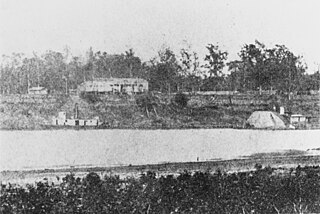
Laurent Millaudon was a wooden side-wheel river steamboat launched at Cincinnati, Ohio, in 1856 operating in the New Orleans, Louisiana, area, and captained by W. S. Whann. At the beginning of the American Civil War she was taken into service by the Confederate Navy as CSS General Sterling Price. On 6 June 1862, she was sunk at the Battle of Memphis. She was raised and repaired by the Union army, and on 16 June 1862 was moved into Union service as USS General Price and served until the end of the war.
USS John P. Jackson (1860) was a steamship acquired by the United States Navy during the beginning of the American Civil War. She was assigned to the Union blockade of the Confederate States of America. as well as the bombardment of Mississippi River ports.

USS Dahlia was a paddle-wheel tugboat acquired by the Union Navy during the beginning of the American Civil War. Dahlia was assigned to the Mississippi River area to provide tug and other services to Union ships requiring assistance.
USS Gazelle was a side-wheel steamer acquired by the Union Navy for duty with the Mississippi River Squadron.
USS Antelope was a stern-wheel steamer acquired by the Union Navy for service during the American Civil War. Originally Lavinia Logan—a charter vessel built in 1861 at Parkersburg, Virginia — she was purchased in 1864 to support operations of the Union Army along the streams of the Mississippi River.

USS General Lyon, originally the De Soto, was recaptured from the Confederate States of America and renamed USS De Soto, and then USS General Lyon, after Brigadier General Nathaniel Lyon.
USS Ivy was a steamer acquired by the Union Navy during the American Civil War.

USS Rattler was a steamer acquired by the Union Navy during the American Civil War.

USS Cricket was a steamer acquired by the Union Navy during the American Civil War.

USS St. Clair was a steamer purchased by the Union Navy during the American Civil War.
USS Hastings was a steamer purchased by the Union Navy during the American Civil War. She was used by the Union Navy as a gunboat assigned to patrol Confederate waterways.
USS Paw Paw was a steamer acquired by the Union Navy during the American Civil War. She was used by the Union Navy as a convoy and patrol vessel on Confederate waterways.
USS Exchange was a steamer acquired by the Union Navy during the American Civil War.
USS Juliet was a steamer acquired by the Union Navy during the American Civil War. She was used by the Union Navy as a gunboat in support of the Union Navy blockade of Confederate waterways.
USS Kenwood was a steamer acquired by the Union Navy during the American Civil War. She was used by the Union Navy as a gunboat in support of the Union Navy blockade of Confederate waterways.
USS Alonzo Child was a side-wheel steamer seized by the Union Navy during the American Civil War. She was used by the Union Navy as a barracks ship in support of the Union Navy blockade of Confederate waterways.
USS Huntress was a steamer acquired by the Union Navy during the American Civil War. She was placed into service as a gunboat assigned to support the Union Navy during the naval blockade of ports and rivers of the Confederate States of America.
USS Pink was a steamer commissioned by the Union Navy during the American Civil War. She served the Union Navy's struggle against the Confederate States of America in various ways: as a tugboat, a gunboat, and as a small transport.

USS Rodolph was a steamer commissioned by the Union Navy during the American Civil War. She served the Union Navy during its struggle against the Confederate States of America, both as a tugboat and a minesweeper, as well as a gunboat when the occasion demanded. Just as the war was ending, Rodolph struck a mine and sank, with four of her crew killed and a number of others wounded.
USS Tallahatchie was a 171-ton steamer acquired by the Union Navy during the American Civil War for service against the Confederate States of America.







